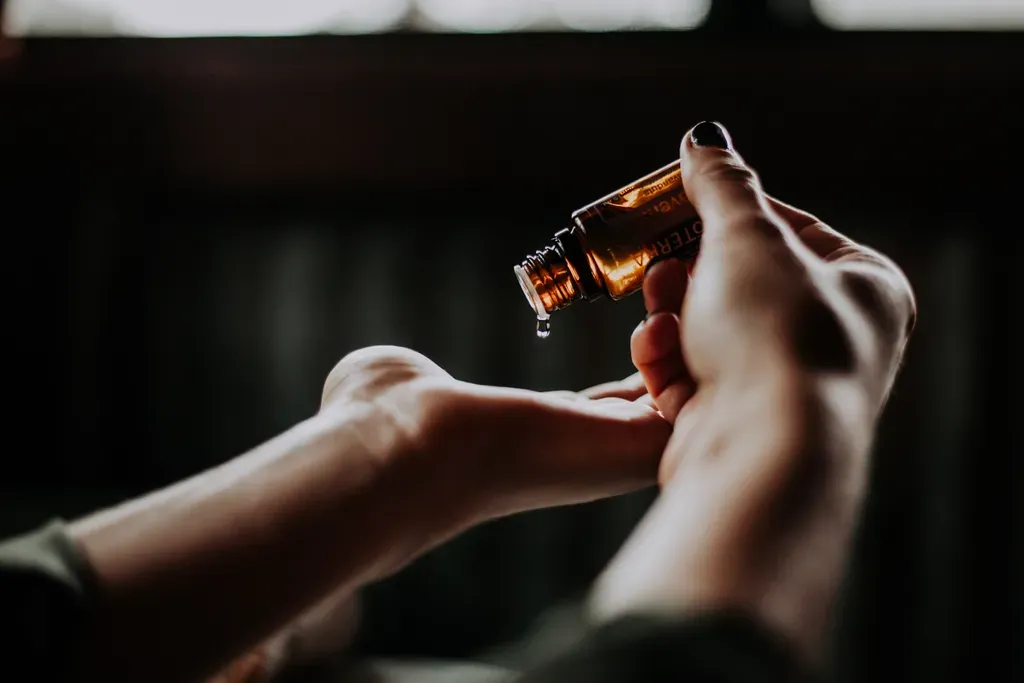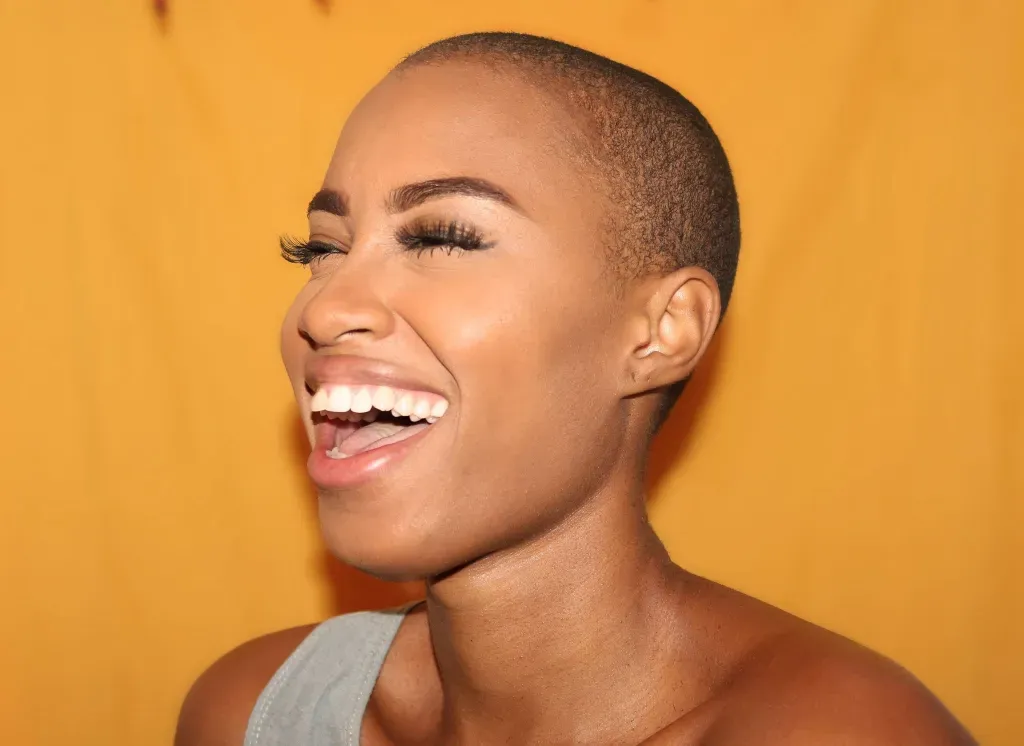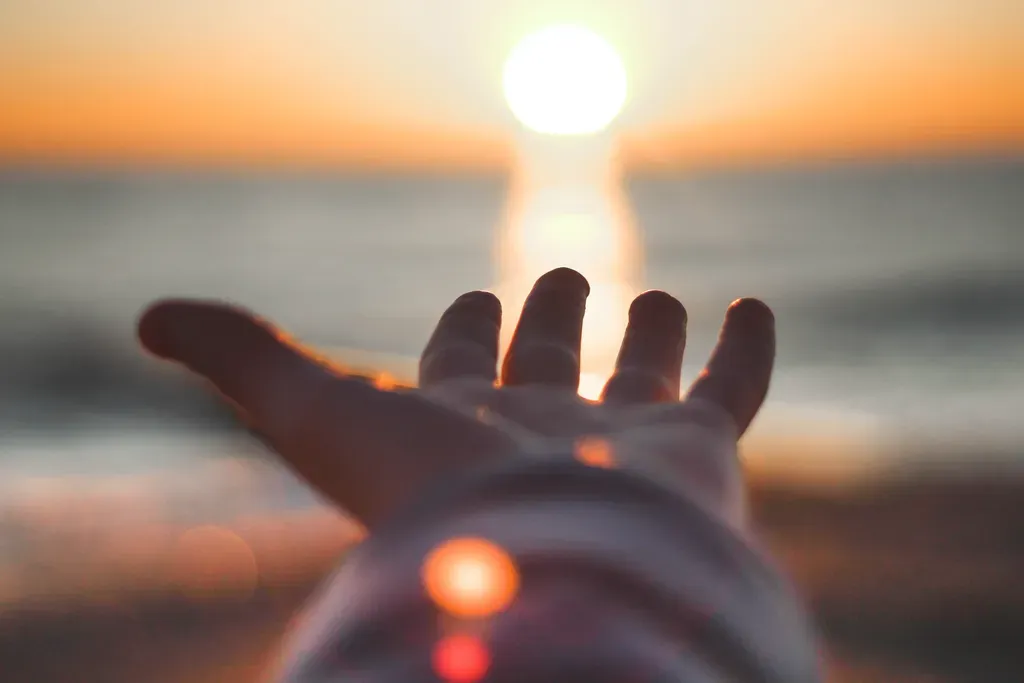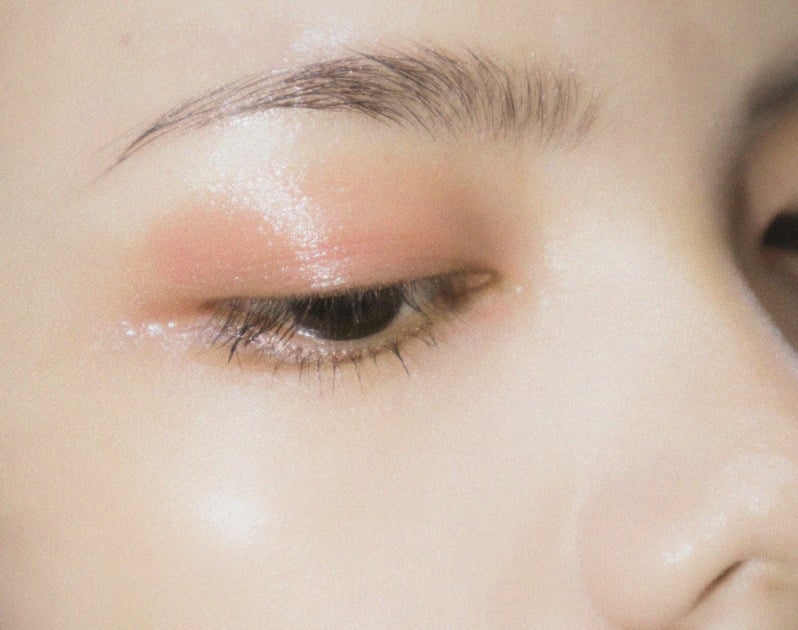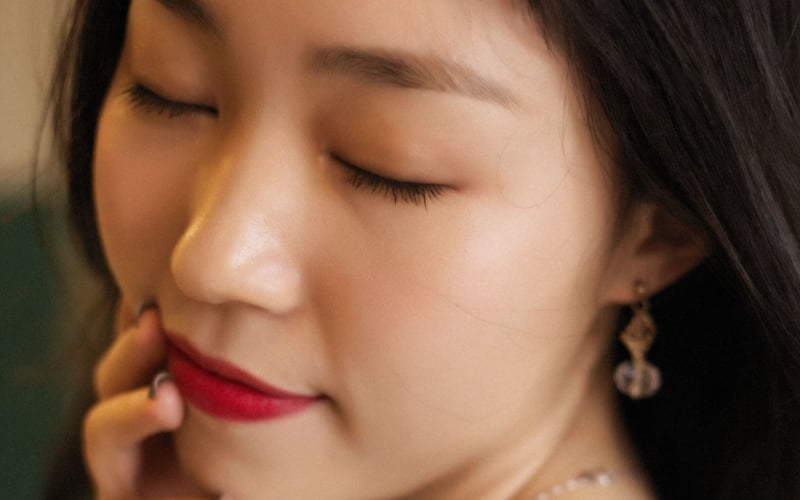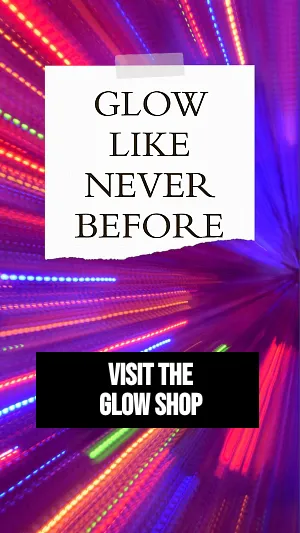The 10-Step Korean Skincare Routine for Cleansing, Hydrating, and Protecting Your Skin
In this guide, I’ll go over the 10-Step Korean Skincare Routine and how I’ve tweaked it to get amazing results!

K-beauty has a notorious reputation for being high-maintenance. Much of that reputation stems from the fact that many Koreans place a high premium on even, unblemished skin.
In the pursuit of perfect skin, a lot of magazines and influencers have talked about the benefits of adopting a 10 or even 14-step skincare routine. While on the surface, it may seem impossibly time-consuming, it’s also important to remember how K-beauty products lend themselves to such a multi-tiered skincare routine.
A lot K-beauty products are known to have a thinner, lightweight consistency. Depending on the individual product and its purpose, the texture can range from watery to more gel-like to a milky emulsion.
Rather than slapping on a cream and calling it a day, Koreans believe in patting and layering their skincare to ensure that the product is thoroughly absorbed into the skin.
There is a sequence to follow, starting from products with the thinnest texture, and then progressively moving to thicker textures. This method allows the skin to be more deeply hydrated and minimizes the chances of breaking out since you’re not relying on a thick, occlusive moisturizer to sit on top of the skin.
To understand each product and their purpose, it helps to break down the multi-step skincare routine:
Table of Contents
- Cleanser
- Exfoliator
- Toner
- Essence
- Serums, Ampoule, and Skin Boosters
- Masks
- Eye Cream
- Moisturizer
- Sunscreen
- Sleeping Mask
- Acne Pimple Patch (Optional)
- Is a 10-step Routine Even Needed?
1) Cleanser
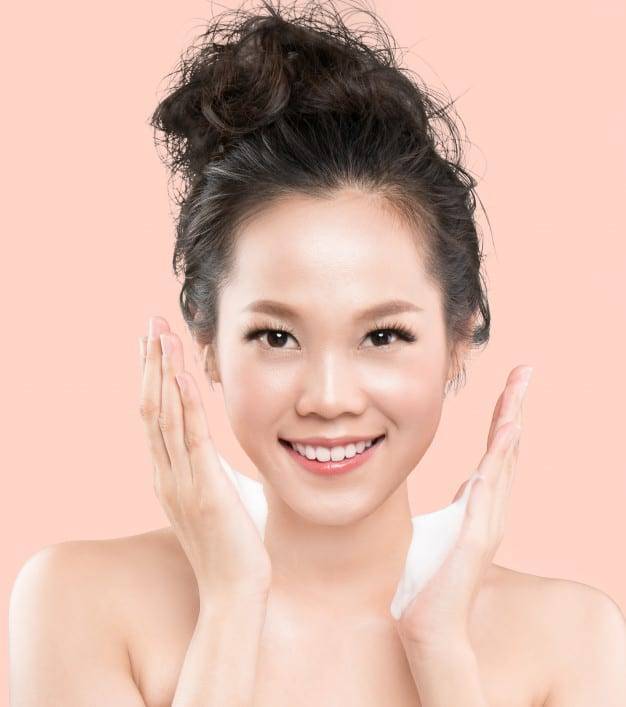
Designed by Freepik / Towaiphoto
Double cleansing is the backbone of Korean skincare. That’s because to get closer to flawless skin, you need to make sure that the skin is clean and receptive to the rest of your skincare regimen.
The first step involves an oil-based cleanser that can be in liquid or balm form. The benefit of using an oil cleanser is that it effectively breaks down layers of sunscreen, city grime and makeup on your face. You can also use this opportunity for a lymphatic massage to relax tense facial muscles and improve circulation.
A balm cleanser is basically a liquid cleanser but it is solid at room temperature. The consistency can vary from waxy to creamy to a more sherbet-like texture.
Once the product is massaged into the skin, the overall effect is similar to an oil cleanser in that it will spread easily across the face and effectively breakdown layers of sunscreen, sebum, dirt and makeup. Some people prefer balms because it’s easier to travel with and certain balms can provide additional hydrating benefits.
Those who are acne-prone might be afraid to use an oil-based cleanser for fear of worsening their breakouts. However, there are many oil and balm cleansers out on the market that are designed to emulsify and wash away with water. When shopping for a new oil or balm cleanser, look for ingredients such as polyethylene, polyethylene glycol, pentylene glycol, and polydiethyleneglycol. These are just some of the ingredients that help oil and balm cleansers dissolve when they come in contact with water.
An added advantage of the two-step cleansing method is that the oil cleanser is always followed up with a water-based cleanser to ensure that the last traces of oil and makeup are broken down.
A water-based cleanser can include a foaming, gel, lotion and cream cleanser. If you’re unsure about the type of cleanser you’re looking at, just look for water listed as the first ingredient. Your skin type will dictate what type of water based cleanser you will use.
Generally, oily and normal skin will favor foaming and gel cleansers, though depending on the ph level, some of these cleansers could suit moderately dry and sensitive skin.
If your skin is extremely dry and can’t handle foam cleansers, then look for gentle milk cleansers that will not aggravate the skin.
What these different cleansers show is that double cleansing can work on a wide variety of skin types by effectively removing dirt and makeup and creating a healthy base for the rest of your skincare regimen.
2) Exfoliator
There are two major types of exfoliation and other variations that you can commonly find. The first is physical or manual exfoliation which involves a granular substance. When rubbed against the skin, the granules will slough off dead skin cells to reveal a fresh new layer of skin underneath.
An example of a physical exfoliant is Skin Food’s Black Sugar Mask which features sugar granules in a thick, paste-like formula. The granules are gently rubbed into the skin and left on for about 10-15 seconds. The paste, which is composed of macadamia seed oil, shea butter and meadowfoam oil, works to moisturize the skin even after it’s washed off.
If your skin is sensitive and can’t handle the abrasiveness of mechanical exfoliation, then there are a whole host of chemical exfoliants that you can choose from. Chemical exfoliants include different families of acids including alpha hydroxy acids (AHAs), beta hydroxy acids (BHAs) and polyhydroxy acids (PHAs).
AHAs consist of a range of acids including glycolic acid, lactic, mandelic, malic, tartaric and citric. They work by dissolving the top layer of skin and paving the way for fresh new skin to appear. With consistent use, AHAs can improve pigmentation and help to regenerate new collagen.
Of all the AHAs, glycolic acid has the smallest molecules and will absorb much faster into the skin. It is considered the most effective, but at higher percentages, it can also be sensitizing. As such, if your skin can’t handle glycolic acid, then you may want to consider other AHAs such as lactic acid or mandelic acid, which has larger molecules and absorb slower into the skin (source).
BHA (beta hydroxy acid) is synonymous with salicylic acid. It’s derived from the same source as aspirin, and it works to provide a different form exfoliation from AHAs.
Unlike glycolic acid which provides a more superficial form of exfoliation, salicylic acid is oil-soluble, so it goes deeper inside the pore to clear out the oils trapped inside. It’s especially beneficial for those with oily skin and is an effective ingredient in combating different types of acne, especially blackheads and whiteheads because it’s able to reach acne-causing bacteria in a much more effective way than other acids.
For many years, salicylic acid was heavily regulated by the Korean government, so while it’s easy to find formulations with 2% salicylic acid in the U.S., you will be hard-pressed to find that type of concentration in Korean products (source). This is great news for people who are both sensitive and acne-prone because that means that as a consumer, you can easily find BHA products that effectively treat blemishes while avoiding the drying effects of salicylic acid.
In the final category of acids, we have polyhydroxy acids (PHAs) which is considered to be a distant relative of AHAs. The can be most commonly listed as gluconolactone, galactose and lactobionic acid. They provide an even gentler form of exfoliation than AHAs and BHAs, and can spare you from photosensitivity to UV rays. An added benefit is that they can also provide hydrating benefits to the skin. So, if your skin is hypersensitive, or if you’re new to chemical exfoliants, then using a product with PHAs could be a good place to start.
3) Toner
Once the skin is exfoliated, it needs to be both restored and nourished. Using a toner is the first step in balancing out the skin after it’s been cleansed.
Unlike toners that you would find in the drugstore, Korean toners are not meant to be astringent. In fact, they often contain hydrating ingredients such as plant-based oils, hyaluronic acid, and panthenol to provide an important first layer of moisture.
A popular trend is the 7-skin method which involves gently patting the toner, wait for it to dry and proceed with another layer of toner until you’ve reached your 7th layer (source). By using this method, the skin becomes less reliant on thick moisturizers since you’re using your toner to create a base of hydration.
While it can be argued that toner is an optional part of skincare, it certainly has a place in a K-beauty regimen. That’s because with double cleansing, the skin can get stripped by the use of tap water which contains drying elements such as chlorine and calcium. Using a toner after cleansing is a nice way to rebalance your skin and ensure that it’s primed for the products to follow.
4) Essence
If there’s a product that is quintessentially Korean, it would definitely be skin essence. It’s the perfect medium between a toner and a serum, but it’s still packed with nutrient-dense ingredients.
An essence is especially beneficial if you have dry and dehydrated skin. Since essences tend to be denser than toners with water-retaining humectants such as hyaluronic acid and glycerin, it provides a much-needed layer of hydration and helps bolster your serum or moisturizer. In addition to humectants, many essences also include ingredients to help improve skin tone. Ingredients such as propolis, green tea and niacinamide work to reduce redness and improve the appearance of pores. It works best by pouring a dime-size of the essence into your palm and then gently patting it into the skin. It creates another base of hydration and preps the skin for serum.
The consistency and application of essences can vary. They can be watery and almost toner-like or have a thicker viscosity. Essences will usually contain sodium hyaluronate, squalane and/or fermented ingredients to provide gentle hydration and boost the skin’s clarity.
5) Serums, Ampoule, and Skin Boosters
Serums pack a punch in tiny packaging. These are concentrated formulations with smaller molecules, so they absorb into the skin much faster.
A serum is often used as a treatment product to target issues such as blemishes, pigmentation and dehydration. If your skin is in fairly good shape, then a serum can be optional.
However, if you do have any skin issues, then choose a serum with the right active ingredients to treat your skin ailments. If acne is your concern, then serums with active ingredients such as tea tree oil and lactic acid can treat breakouts in a gentle manner.
If you want to treat discoloration, then look for ingredients such as vitamin c, licorice extract, niacinamide or arbutin which work to lighten dark marks and brighten the complexion.
Other products have since come onto the market that have a similar purpose as serum. These products are also known as ampoules or skin boosters. They work by adding moisturizing benefits to your skincare and help your skin to appear smooth and glossy.
6) Masks
Sheet Mask: While masks aren’t considered an everyday part of the K-beauty skin routine, they play an important role in recharging your skin.

Designed by Freepik / Benzoix
Often times, when we stick to the same routine, our skin can get fatigued and it won’t show the same lustre even though we’re pampering it with essence and moisturizer. That’s where masks come in because they basically provide a jolt of hydration, as well as antioxidants and peptides, depending on the mask.
Sheet masks provide the ultimate convenience in that you can simply place the pre-soaked mask on your face and let it rest on your face for 10-15 minutes before taking it off. It’s important not to let the mask dry on your face as it can draw moisture out of the skin if left on for too long.
Peel-off Masks: In a different category of masks, you will find peel-off masks. They can encompass rubber masks and thinner-textured masks. These masks follow the same process where you spread the product all over your face, wait for it to dry and then slowly peel it off.
Rubber masks on the other hand, form a thicker protective layer over the skin. It provides both cooling and hydrating benefits, while sucking out the impurities from the skin.
7) Eye Cream
The first signs of aging show up around your eyes. It can show up as fine lines or dark pockets underneath your eyes that don’t seem to go away–even after a good night’s rest. A good eye cream can help address your pesky issues and hydrate the thin skin around the eyes.
Depending on your concerns, you will want to choose an eye cream based on texture and ingredients. If your concern is discoloration, then you can look for creams with licorice or bilberry extract for its anti-inflammatory benefits.
Arbutin is also another ingredient to look for. In studies, arbutin has been proven to suppress melanin and is a safer alternative to hydroquinone. improve skin health around the eyes, look for moisturizers with ginseng. It is rich with antioxidants and helps repair aging caused by sun damage.
8) Moisturizer
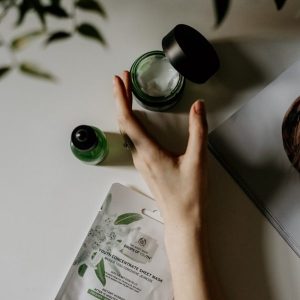
With Korean skin care, you can find a wide range of moisturizers to suit your needs. If you have dry skin, don’t underestimate the moisturizing capabilities of gel creams.
As mentioned before, a Korean moisturizer doesn’t function as a standalone product. Rather, they build upon previous layers of skincare to lock in active ingredients and add extra hydration. So, if you’ve incorporate products such as a hydrating essence or serum, then you might find that you don’t need such a heavy moisturizer to hydrate your skin.
Whether you’re choosing a water cream or a thicker anti-aging cream, there’s often gel-like quality to Korean moisturizers. While the slippery texture can often be attributed to the presence of silicones, Korean moisturizers will often include a combination of natural oils and synthetic ingredients to provide sustained hydration.
The combination allows for a pleasant application of the product and allow for the skin to reap the full benefits of what nature and the lab have to offer.
9) Sunscreen

During the AM, wearing sunscreen is an essential part of a K beauty regimen. To avoid the formation of brown marks and maintain the skin’s clarity, an SPF is needed to protect the skin from the sun’s harmful rays. For those living in a densely populated city, a sunscreen is also an essential weapon against skin-aging pollutants.
Many Korean sunscreens are formulated to be cosmetically elegant and can also double as makeup primer. Korean sunscreens come with a range of UV shields ranging from chemical filters to physical blocks and a combination of both chemical and mineral protectants. In most cases, the most lightweight texture will be marketed as gel sunscreen.
In gel vehicles, there is usually the presence of alcohol which is used to stabilize the product and dry quickly on the skin. If you are sensitive to high concentrations of alcohol then be sure to read through the ingredients carefully so that you are selecting the best SPF for your skin type.
For those who are new to Korean sunscreens, you will notice that the bottle will indicate both an SPF with a number. The SPF refers to the sun protection factor which measures how well the product protects the skin from UVB rays. These rays are what causes sunburns and they play a large role in the formation of skin cancers.
In the U.S. most shoppers will rely on the SPF factor and the term “broad spectrum” when deciding on a sunscreen. When a sunscreen indicates that it’s broad spectrum, it means that it provides protection against UVA and UVB rays, though the amount of protection against UVA is unclear.
The PA rating system is commonly used in East Asian countries such as Japan, Korea and China. The system focuses on protection against UVA rays, which reaches deeper into the skin than UVB rays and is the leading cause of skin aging and wrinkling.
The PA is usually followed by one to four + signs which indicates the level of UVA protection ranging from a little to extremely high.
Though no rating system is full-proof, having access to both ratings will give you a better idea of how well the sunscreen will protect you from the sun’s damaging rays. Here’s an easy way to remember the ratings:
- PA+ Some UVA Protection
- PA++ Moderate UVA Protection
- PA+++ Very Good UVA Protection
- PA++++ Extremely High UVA Protection
10) Sleeping Mask
In the PM if your skin needs an additional layer of hydration after your moisturizer, then a sleeping mask is a great way to replenish dry skin. With a gel-lotion consistency, you simply spread an even layer across your face and leave it on overnight. The mask can then be washed off in the morning and it ensures that the skin softened for the next day.
For some overnight sleeping masks, they can replace your everyday moisturizer by providing super-charged hydration. If used as a moisturizer replacement, it can serve as a nice break from your usual routine.
Acne Pimple Patch (Optional)
If you notice a pimple cropping up and need a more localized treatment, then a pimple patch is an effective way to stop a blemish in its tracks. The patch is usually circular shaped and looks like a clear band aid. After placing the patch on the pimple, you will need to wait for a few hours (or even overnight). The patch will vacuum the oil and debris from the pimple, and you will notice the patch expanding with white fluid.
With a pimple patch you won’t have to turn to drying treatments such as benzoyl peroxide which can leave behind red flaky skin where the pimple used to be. Using the patch also creates a physical barrier between the pimple and your fingers–preventing any temptation to squeeze or tamper with an active bump.
Is a 10-step Routine Even Needed?
Even though I’ve spent a lot of time talking about the 10-step routine, I personally don’t think that all those products are needed. Particularly for someone with sensitive skin, layering on too many products could trigger a reaction.
The value in the 10-step routine, however, is understanding each individual product’s purpose, and how they build upon each other in a well-thought-out skincare regimen. In fact, a regimen consisting of just 4-5 products can effectively clean and hydrate your skin as well as treat any skin issues you may have.
When putting together your K-beauty routine, try to think about how your products will support your four major skincare pillars:
- Cleansing
- Hydrating
- Protecting
- Treating
For instance, my skin is both acne-prone and dry, and I have residual pigmentation from previous breakouts. My goal is to moisturize my skin without triggering new breakouts and lighten the marks left behind by previous acne.
Here’s a snapshot of what my typical skincare routine looks like:
- Double Cleanse (PM only)
- Essence
- Vitamin C serum (AM), Peptide Serum (PM)
- Sunscreen (AM)
- Moisturizer
In the morning, I choose not to wash my face with a cleanser, because I’ve done the bulk of my skincare the night before. As someone with sensitive skin, cleansing can be very drying, so I don’t want to overstrip my skin barrier by cleansing in the morning.
After washing/cleansing my face, I use an essence. Since it has such a watery texture, it functions both as a toner and as a first layer of hydration. The product is mostly made up of lotus extract which has shown potential anti-aging benefits (source).
I then use a serum that has a targeted purpose. In the morning I use a vitamin C serum to brighten my skin and provide added protection from the UV rays. It also does a great job in lightening unwanted pigmentation and I get to benefit from its collagen-boosting qualities.
I then use a serum that has a targeted purpose. In the morning I use a vitamin C serum to brighten my skin and provide added protection from the UV rays. It also does a great job in lightening unwanted pigmentation and I get to benefit from its collagen-boosting qualities.
I then seal in the serum with a medium-weight moisturizer that contains centella asiatica to soothe away red, ruddy skin.
Without a doubt, the most important part of my morning routine is sunscreen. With Korean sunscreens, there are so many high quality products to choose from, so I’ll usually rotate between a couple of different formulations depending on my level of outdoor activity.
In the evening, the most important part of my skincare routine is double cleansing. I start off by using a balm cleanser to effectively melt away the layers of sunscreen, sebum and pollution. I then follow up with a foaming cleanser to remove the last traces of dirt on my face.
After essence, I use a serum with hyaluronic acid and peptides. The combination of ingredients allows for my skin to retain water and also address some of the signs of aging such as light wrinkles and sagging.
Then, I apply moisturizer and call it a night.
- A couple times a week I will use an exfoliator and a sheet mask. This usually takes place right after cleansing. I find that on days when I use a sheet mask, and I can skip the use of serum, since the residue left behind the mask provides ample hydration.
**If my skin is feeling particularly dry, then I will put on a layer of sleeping mask on top of my moisturizer. It’s a great way to add extra hydration when I’m short on time and don’t have time for a sheet mask.
I realize that my routine won’t work for everyone. The bigger point is that by understanding the different products that K-beauty has to offer, I’ve been able to adapt my routine to fit my needs and goals. Depending on if my skin is feeling more oily or dry, I’ll either switch out products or incorporate certain ingredients to address my needs.
Just as I’ve been able to tailor my K-beauty routine you can also use the 10-step guide to figure out what types of products will be the most beneficial for your skin. The variations are endless, and with the constant innovation that is coming from Korea’s skincare industry, there will always be new, groundbreaking products that can help you achieve your best skin.
Thanks for reading this article!

